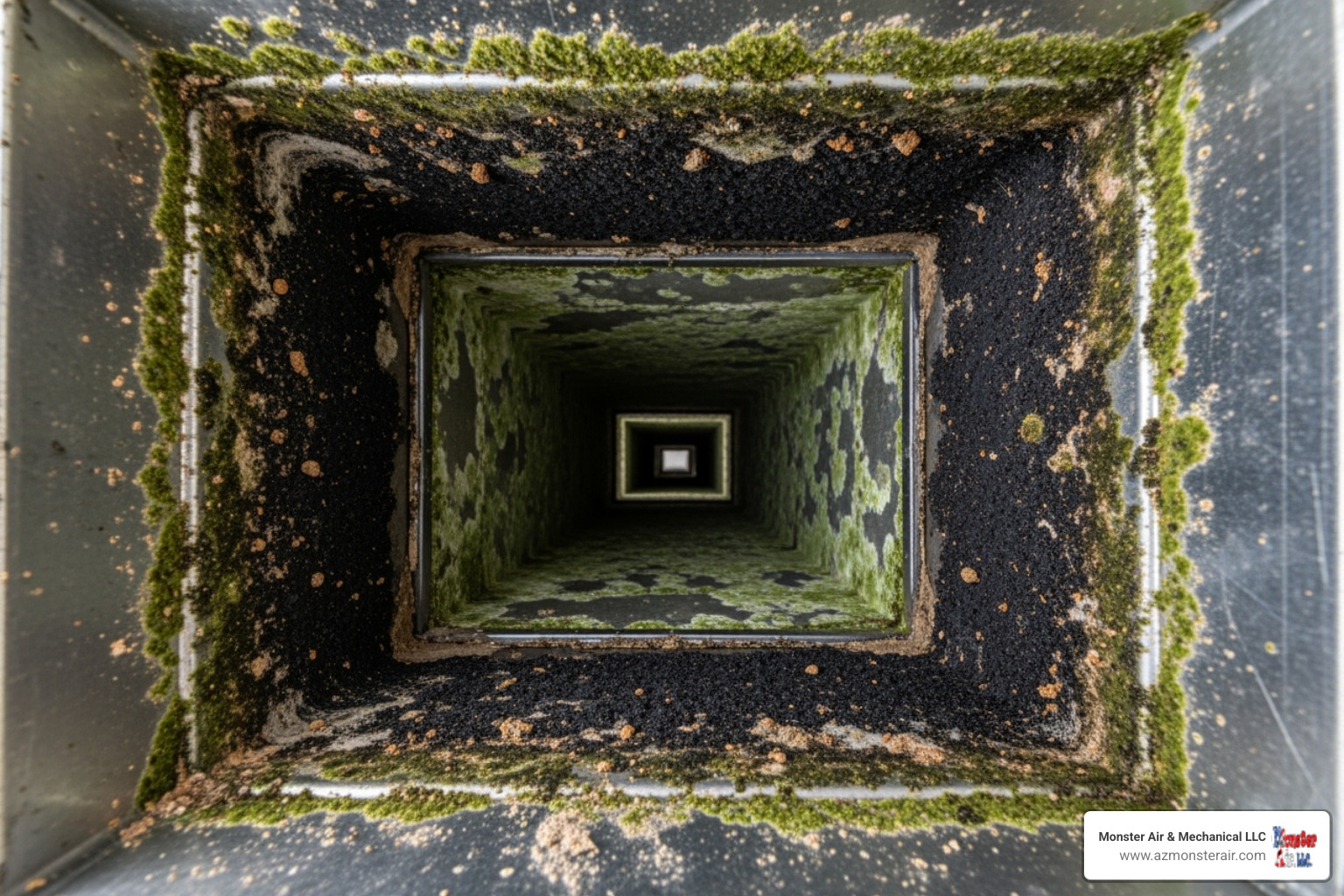Why Flexible Ductwork Cleaning Matters for Your Home
Cleaning flexible ductwork is possible and beneficial when done correctly by trained professionals, but it requires specialized tools and techniques to avoid damaging the delicate inner liner. Unlike rigid metal ducts, flexible ducts can tear, collapse, or puncture if cleaned improperly, making professional service essential for safe and effective results.
Quick Answer: Can Flexible Ducts Be Cleaned?
- Yes, they can be cleaned - but only with proper equipment and expertise
- Professional cleaning improves indoor air quality and HVAC efficiency
- DIY attempts often cause damage - tears, punctures, or collapsed ducts
- Professionals use soft-bristle brushes, HEPA vacuums, and low-pressure air whips
- Typical cleaning frequency - every 3-5 years for most homes
- Sometimes replacement is better - if ducts show extensive mold, pest damage, or age-related deterioration
If you've ever looked inside your HVAC system or pulled off a vent cover, you might have noticed that gray, fuzzy buildup inside. That's dust, allergens, pet dander, and possibly mold spores circulating through your home every time your system runs.
For years, there's been debate in the HVAC industry about whether flexible ductwork can actually be cleaned without causing more harm than good. Some claim that the cleaning process damages these delicate ducts. Others insist that with the right approach, cleaning is not only safe but necessary for maintaining healthy indoor air.
The truth? Flexible ducts can be cleaned safely - but the process requires specialized knowledge, proper equipment, and careful technique. The material is far more delicate than traditional metal ductwork, which means aggressive cleaning methods can easily tear the inner liner or cause the duct to collapse.
This article cuts through the confusion. We'll explain what flexible ductwork is, when cleaning makes sense, how professionals do it safely, and when replacement is the smarter choice. Whether you're dealing with musty odors, visible dust blowing from vents, or just want to maintain your system, you'll learn exactly what to expect from professional flexible duct cleaning.
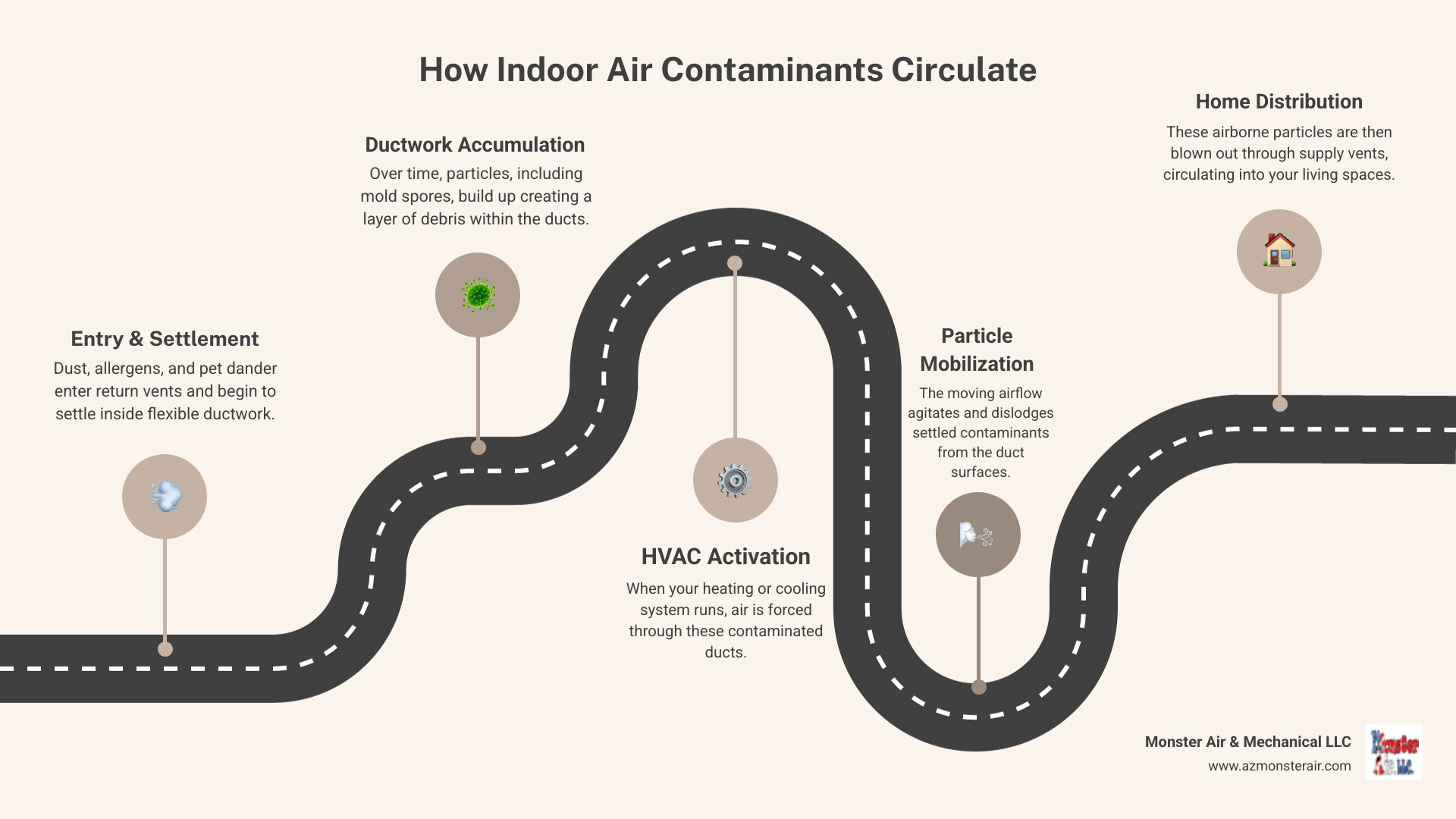
What is Flexible Ductwork and Why Is It Used?
Flexible ductwork, often simply called "flex ducts," are the bendy tubes that carry conditioned air throughout your home's heating, ventilation, and air conditioning (HVAC) system. Unlike their rigid metal counterparts, these ducts are designed to be highly versatile, making them a popular choice for many residential and some commercial installations.
They are typically constructed from a wire coil that provides structural support, encased in an inner liner (often made of plastic or aluminum), and then surrounded by a layer of insulation, all covered by a durable outer jacket. This multi-layered design makes them both flexible and effective at maintaining air temperature.
The primary purpose and advantage of flexible ducts lie in their ability to bend and conform to fit tight spaces or complex layouts. Imagine trying to snake rigid metal pipes around existing plumbing, wiring, or structural beams in an attic or crawl space – it would be a monumental task! Flexible ducts, however, can easily steer these obstacles, offering simpler and quicker installation. This ease of installation often translates to them being a cost-effective option, especially since they are insulated, which helps with energy efficiency.
While rigid ductwork might be preferred for main trunk lines or in areas with ample space, flexible ducts shine in connecting these main lines to individual registers or in challenging installation environments. Flexible ductwork can last anywhere between 10 and even 30 years, depending on how well they’re maintained, environmental factors that may lead to deterioration, and other circumstances. You will often find flexible air ducting in homes with slab foundations or furnaces placed in attics due to installation challenges with rigid ducting.
The Case for Cleaning: Benefits for Your Health and HVAC System
Think about everything that floats through your home's air on any given day. Pet hair from your furry friends. Pollen tracked in from outside. Dust that seems to appear out of nowhere. Cooking odors. Even tiny fibers from carpets and furniture. Now imagine all of that getting sucked into your HVAC system and settling into the ridges and folds of your flexible ductwork.
That's exactly what happens over time. The corrugated interior of flexible ducts, with all those peaks and valleys, creates the perfect hiding spots for dust, allergens, and other particles to accumulate. Once they're there, every time your heating or cooling kicks on, some of those contaminants get blown right back into the rooms where you live, eat, and sleep.
The good news? Professional cleaning flexible ductwork can dramatically improve the air you breathe and help your entire HVAC system run better. Here's what clean ducts mean for your home:
Cleaner, healthier air is the biggest win. When dust, pollen, pet dander, and mold spores build up in your ductwork, they don't just sit there quietly. They circulate through your home every single time your system runs. For anyone dealing with allergies, asthma, or respiratory sensitivities, this constant exposure can trigger symptoms and make daily life uncomfortable. Professional cleaning removes these irritants right from the source, giving you fresher air that's easier to breathe. If you're concerned about what you're breathing at home, our Indoor Air Quality Services can help you understand your options.
That musty smell you've been trying to ignore? It might be coming from your ducts. Dirt, dust, and sometimes mold growth can create persistent odors that air fresheners just can't cover up. When you clean the ducts properly, you eliminate these odor sources rather than masking them, leaving your home genuinely fresher.
Your HVAC system works harder when it has to push air through dust-clogged ducts. It's like trying to breathe through a dirty air filter versus a clean one. This extra effort means your system uses more energy to heat or cool your home to the same temperature. Clean ducts allow air to flow freely, which can improve efficiency and potentially lower your energy bills.
Equipment that doesn't strain lasts longer. When your HVAC system isn't fighting against blocked airways, it experiences less wear and tear on its components. Regular duct cleaning is an investment in extending the life of your entire heating and cooling system.
And if you've ever dealt with mold in your home, you know how concerning it can be. Flexible ducts exposed to moisture can become breeding grounds for mold growth. Professional cleaning flexible ductwork removes existing mold and significantly reduces the number of mold spores circulating through your living spaces, protecting both your health and your home.
The bottom line? Clean ducts mean cleaner air, a more efficient system, and a healthier home for everyone under your roof.
The Professional Method for Cleaning Flexible Ductwork
When it comes to cleaning flexible ductwork, understanding the difference between a DIY attempt and professional service can save you thousands in replacement costs. Unlike sturdy metal ducts, flexible ducts have a delicate inner liner requiring a gentle, specialized approach.
Think of it as washing fine china versus a cast-iron pan—the technique matters enormously.
Here's how DIY attempts stack up against professional cleaning:
| Feature | DIY Cleaning | Professional Cleaning |
|---|---|---|
| Tools | Household vacuum, brushes, leaf blowers, improvised tools | High-powered HEPA vacuums, specialized rotary brushes, air whips, negative air machines |
| Risks | High risk of tearing, puncturing, collapsing ducts; spreading contaminants; mold growth | Minimal risk of damage with trained technicians; proper containment of debris |
| Effectiveness | Often superficial; pushes debris further; ineffective against mold/contaminants | Thorough removal of dust, allergens, mold spores, and debris; sanitization options |
| Outcome | Potential for damage, voided warranties, persistent air quality issues | Improved indoor air quality, HVAC efficiency, system longevity, peace of mind |
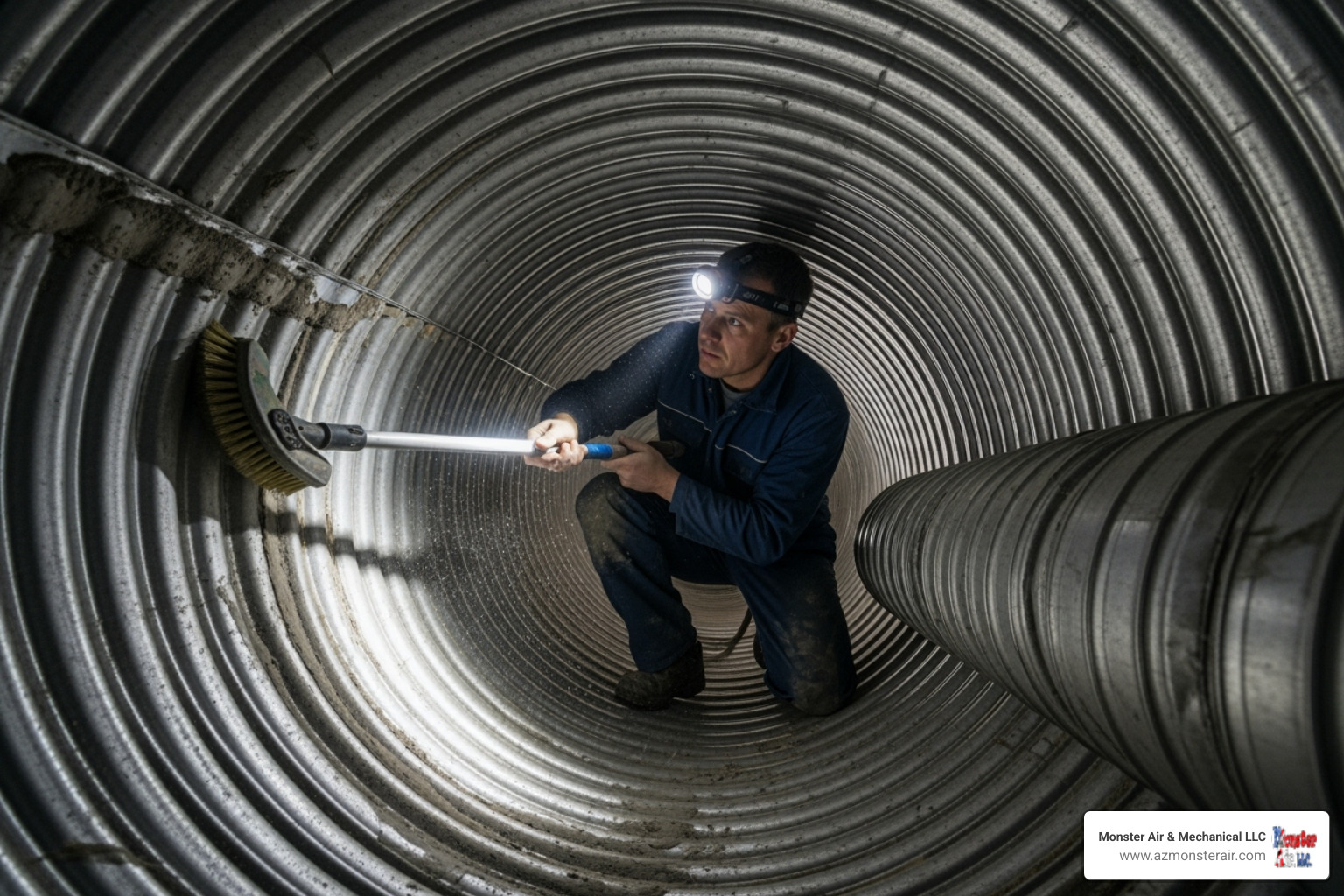
The Dangers of DIY and Improper Cleaning
While DIY projects can be satisfying, cleaning flexible ductwork is one job where good intentions can lead to expensive consequences.
The biggest problem is that flexible ducts can't handle household cleaning tools. A Shop-Vac lacks the needed attachments and controlled suction. A stiff brush can easily puncture the thin inner liner, creating air leaks that hurt your system's efficiency.
Worse, without proper containment, you can make your indoor air quality worse. Using improvised tools without negative air pressure to capture debris will blow dust, mold, and allergens directly into your living spaces.
The outer vapor barrier protects the insulation and prevents moisture. If damaged, you risk condensation, reduced efficiency, and hidden mold growth.
Many homeowners don't realize that improper cleaning can void your HVAC warranty. Damage from untrained individuals isn't covered, so a "free" DIY job could cost you thousands later.
Professional Tools and Techniques
Professional duct cleaning is about working smarter with the right equipment. Our technicians use specialized tools designed for the delicate nature of flexible ductwork.
Every job starts with a thorough pre-cleaning inspection. We visually examine your ductwork to assess its condition, identify damage, and decide if cleaning is the right solution. This is critical for flexible ducts, where age and wear can make cleaning risky.
Once cleaning is confirmed, we use high-powered HEPA vacuums to create negative air pressure in your duct system. This is key to effective cleaning. As tools dislodge debris, the negative pressure pulls it out through HEPA filters, preventing redistribution into your home.
We follow NADCA's industry standards for negative air cleaning. Contrary to some myths, NADCA confirms negative air pressure is safe for flexible ductwork. Modern flex ducts have metal spiral support that withstands proper professional cleaning.
For cleaning, we use soft-bristle rotary brushes and low-pressure air whips designed for flexible ducts. These tools gently agitate contaminants without damaging the liner. A reverse air mechanism pulls debris toward the vacuum, unlike DIY methods that push it further in.
After cleaning, a post-cleaning visual inspection verifies the ducts are clean and undamaged. We also check connections and test airflow for optimal function. This final step ensures the job was done right.
When choosing a duct cleaning service, look for companies that follow NADCA's air duct cleaning standards and, if your ducts contain fiberglass components, the North American Insulation Manufacturers Association's (NAIMA) recommendations. Adherence to these industry standards is your assurance of quality, professional service.
Is It Time to Clean? Key Signs and When to Replace
Your flexible ductwork won't send a reminder when it needs attention, but your home will give you clues that it's time for professional cleaning flexible ductwork services.
The most obvious sign is visible dust puffing out of your vents when your HVAC system kicks on. If you're constantly wiping away dust, your ducts are likely the source.
Musty or stale odors are another red flag. An unpleasant smell when the AC or heat turns on could signal mold, mildew, or bacteria in your ductwork. If you spot visible mold growth on or around your registers, or see it inside the ducts, it's time to call a professional.
Unwanted houseguests can also be the problem. Signs of pest infestation like droppings or nesting materials near vents mean critters are in your ducts. Pests damage ductwork and introduce allergens and pathogens into your air.
Pay attention to your family's health. Unexplained allergy flare-ups, respiratory irritation, or headaches at home can point to contaminated ducts. Weak airflow from registers is another sign, as clogged ducts are a common culprit.
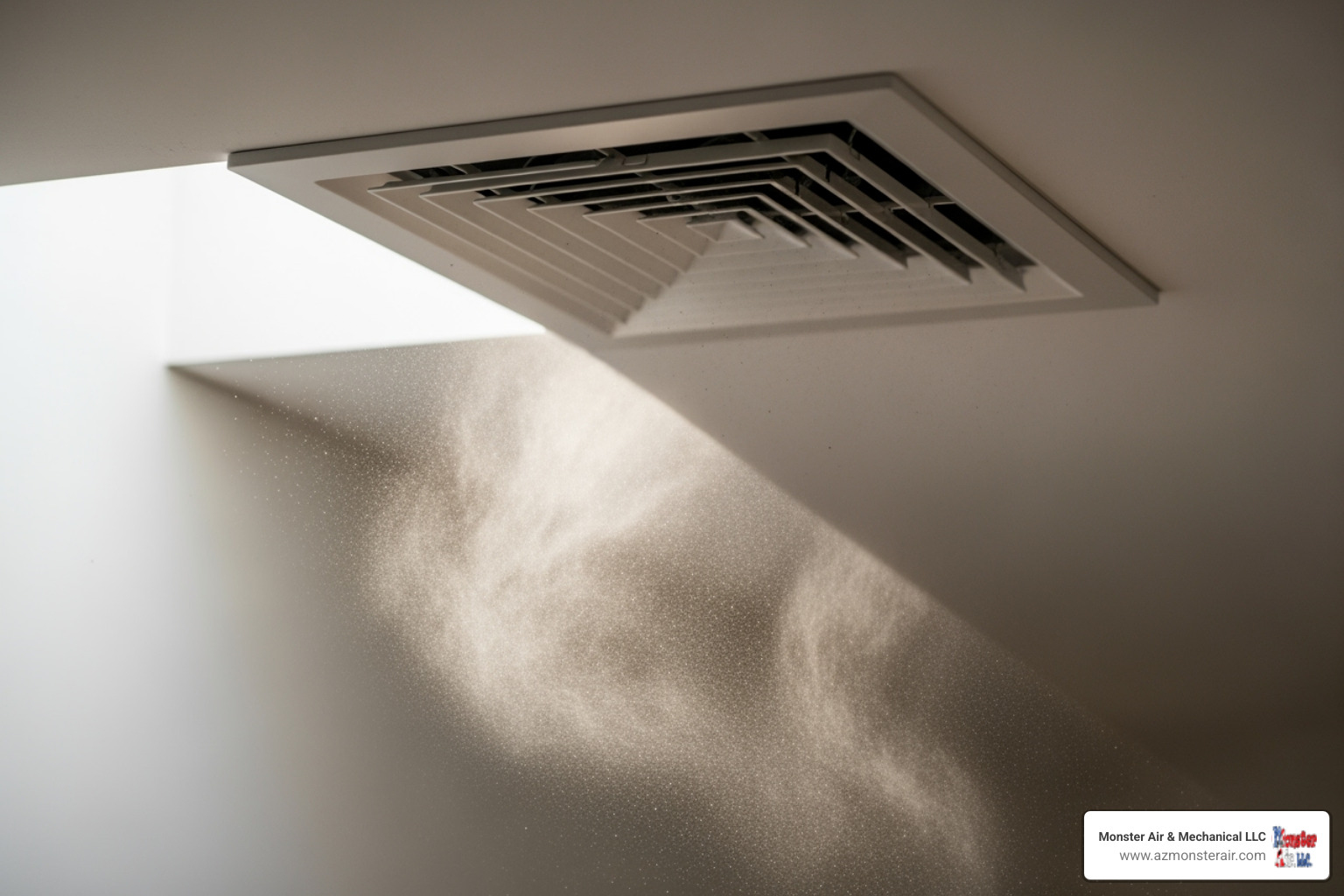
How Often Should You Schedule a Cleaning?
For most homes, professional cleaning flexible ductwork every 3 to 5 years is recommended to keep your system running smoothly and maintain air quality. Regular maintenance helps prevent bigger problems.
However, some circumstances require more frequent cleaning. Homes with pets accumulate dander faster, clogging ducts and triggering allergies. If anyone smokes indoors, residue builds up, creating stubborn odors.
Family members with allergies or asthma benefit from more frequent cleanings, sometimes annually. Reducing airborne irritants can dramatically improve their comfort and health.
Major life events also warrant a cleaning. Recent renovations or construction create fine dust that settles in your ductwork. A post-project cleaning helps you enjoy your new space without breathing construction debris.
Just bought a house? You likely don't know the duct cleaning history. A professional cleaning provides a fresh start and a healthier baseline for your family.
Living in a rural area has its own considerations. These homes often face more outdoor allergens and dust that enter ductwork. If this is your situation, see our guide on Air Duct Cleaning for Rural Properties for specialized advice.
When to Replace Instead of Cleaning Flexible Ductwork
Sometimes cleaning isn't the answer. Flexible ducts are more delicate than rigid metal ones. Certain damage can't be cleaned, and trying would be a waste of money.
Extensive mold or water damage is a deal-breaker. If ducts are soaked or have widespread mold, especially on the insulation, replacement is the only safe option. The EPA states that wet or moldy insulated ducts cannot be effectively cleaned and must be removed. If the moisture source isn't fixed, mold will return.
Significant pest damage also requires replacement. Rodents leave behind contamination, nests, and structural damage that cleaning can't fix. It's not worth risking your family's health to salvage compromised ducts.
Physical damage is another clear sign. Crushed, kinked, or torn ducts restrict airflow and reduce efficiency. Patches rarely restore optimal performance, making new ductwork a better investment.
Age also matters. While flexible ducts can last 10-30 years, ducts over 15 years old often show their age. The materials, especially the inner liner, can become brittle. If your ducts feel stiff or crumbly, cleaning could cause more harm by breaking down the weakened material.
Finally, a deteriorating inner liner—flaking, crumbling, or breaking down—signals the end of the duct's life. Cleaning would only accelerate this process and release more particles into your air.
When we inspect your ductwork, we'll give you an honest assessment. If cleaning will solve the problem, we'll tell you. If replacement is the smarter move, we'll explain why. No upselling, no pressure—just straightforward advice to help you make the best decision for your home and budget.
How to Choose a Qualified Duct Cleaning Service
Choosing the right professional for cleaning flexible ductwork is about protecting your investment and health, not just getting a good deal. Since flexible ducts are delicate, an inexperienced technician with the wrong equipment can turn a cleaning into an expensive replacement.
We've seen homeowners hire a cheap service only to find torn ducts, damaged insulation, or no improvement in air quality. That's why it's crucial to do your homework before hiring.
Start by asking about their specific experience with flexible ductwork. Be direct: "What special techniques do you use to avoid damage?" A qualified professional will explain their process, mentioning tools like soft-bristle brushes, low-pressure air whips, and HEPA-filtered vacuum systems.
Insurance is crucial. A reputable company must have comprehensive liability insurance to protect you if something goes wrong. Ask to see proof of current coverage; a legitimate business will provide it.
Look for transparency. When you call for an estimate, a good company will clearly explain their cleaning method, how they create negative air pressure, and their inspection process. Vague or evasive answers are a red flag.
Read online reviews to see what actual customers say. Did the technicians explain the process? Were they careful? Did air quality improve? You can also find a NADCA professional duct cleaner near you through their official directory.
Beware of high-pressure tactics and wild promises. Be skeptical of guarantees to slash energy bills or cure health problems. While cleaning flexible ductwork helps, honest professionals know results vary. The EPA also cautions against using chemical treatments without a proper assessment.
A quality provider will inspect your ducts before giving a final quote. They should be willing to show you what they find, often using cameras for before-and-after documentation. This visual evidence shows they stand behind their work.
At Monster Air & Mechanical LLC, we believe in fast response, fair pricing, honesty, and top-tier professionalism. We don't cut corners, and we don't use aggressive techniques that risk damaging your flexible ductwork. Our goal is your trust and satisfaction, which means doing the job right the first time.
Certifications to Look For
Certifications are your assurance that a company follows established industry standards. In an industry where anyone with a vacuum can claim to be a duct cleaner, proper certification makes all the difference.
The most important certification to look for is from the National Air Duct Cleaners Association (NADCA). NADCA-certified professionals undergo rigorous training in proper cleaning techniques and safety protocols. They understand the specific challenges of cleaning flexible ductwork and know how to do it without causing damage. When a technician follows NADCA's air duct cleaning standards, you can trust they're using methods proven to be both effective and safe.
If your home has fiberglass duct board or ducts with fiberglass lining, make sure your chosen service provider follows the North American Insulation Manufacturers Association (NAIMA) guidelines. These specialized recommendations help protect the integrity of fiberglass components during the cleaning process.
While the Environmental Protection Agency doesn't certify duct cleaning companies, they do provide valuable guidance that reputable professionals follow. A company familiar with EPA guidelines demonstrates they're staying current with the latest research and recommendations for safe, effective duct cleaning.
Don't forget to check local requirements. Some states require air duct cleaners to hold special licenses. You can verify this through your State Consumer Protection Offices. If your state requires licensing and a company doesn't have it, that tells you everything you need to know.
Certification isn't a guarantee of perfection, but it shows a company's commitment to professionalism and ongoing education. Combined with good reviews, transparent communication, and proper insurance, it gives you the confidence that your flexible ductwork is in capable hands.
Conclusion
Taking care of your home's air quality doesn't have to be a mystery. Cleaning flexible ductwork is absolutely possible when you work with trained professionals who understand how to handle these delicate systems safely and effectively.
Throughout this article, we've walked you through everything you need to know about flexible ducts - from understanding what they are and why they're installed in so many homes, to recognizing the signs that yours need attention. We've shown you why professional cleaning matters for both your health and your HVAC system's performance, and why attempting DIY cleaning can turn a maintenance task into an expensive repair job.
The key takeaway? Yes, flexible ducts can be cleaned, but the job requires specialized equipment, proper technique, and the kind of experience that comes from working with these systems day in and day out. When done right, professional cleaning flexible ductwork improves your indoor air quality, helps your HVAC system run more efficiently, and can even extend the life of your equipment.
You're now equipped to make smart decisions about your home's ductwork. You know when cleaning makes sense, when replacement is the better option, and what to look for when choosing a service provider. That knowledge puts you in control of your home's air quality and comfort.
At Monster Air & Mechanical LLC, we've built our reputation on doing things the right way. We respond quickly when you need us, we charge fair prices, and we tell you the truth about what your system needs - not what makes us the most money. Our team has the training and equipment to clean flexible ducts safely and thoroughly, and we're proud to serve homeowners throughout the Phoenix metro area and beyond.
Your family deserves clean air and a comfortable home. We're here to make that happen.
Ready to breathe easier? Schedule your professional duct cleaning today with Monster Air & Mechanical LLC. We serve communities throughout Arizona, including Apache Junction, Avondale, Buckeye, Casa Grande, Cave Creek, Chandler, Coolidge, Deer Valley, Florence, Fountain Hills, Gilbert, Glendale, Gold Canyon, Goodyear, Happy Valley, Maricopa, Mesa, Peoria, Phoenix, Queen Creek, San Tan Valley, Scottsdale, Sun City, Sun Lakes, Surprise, and Tempe.


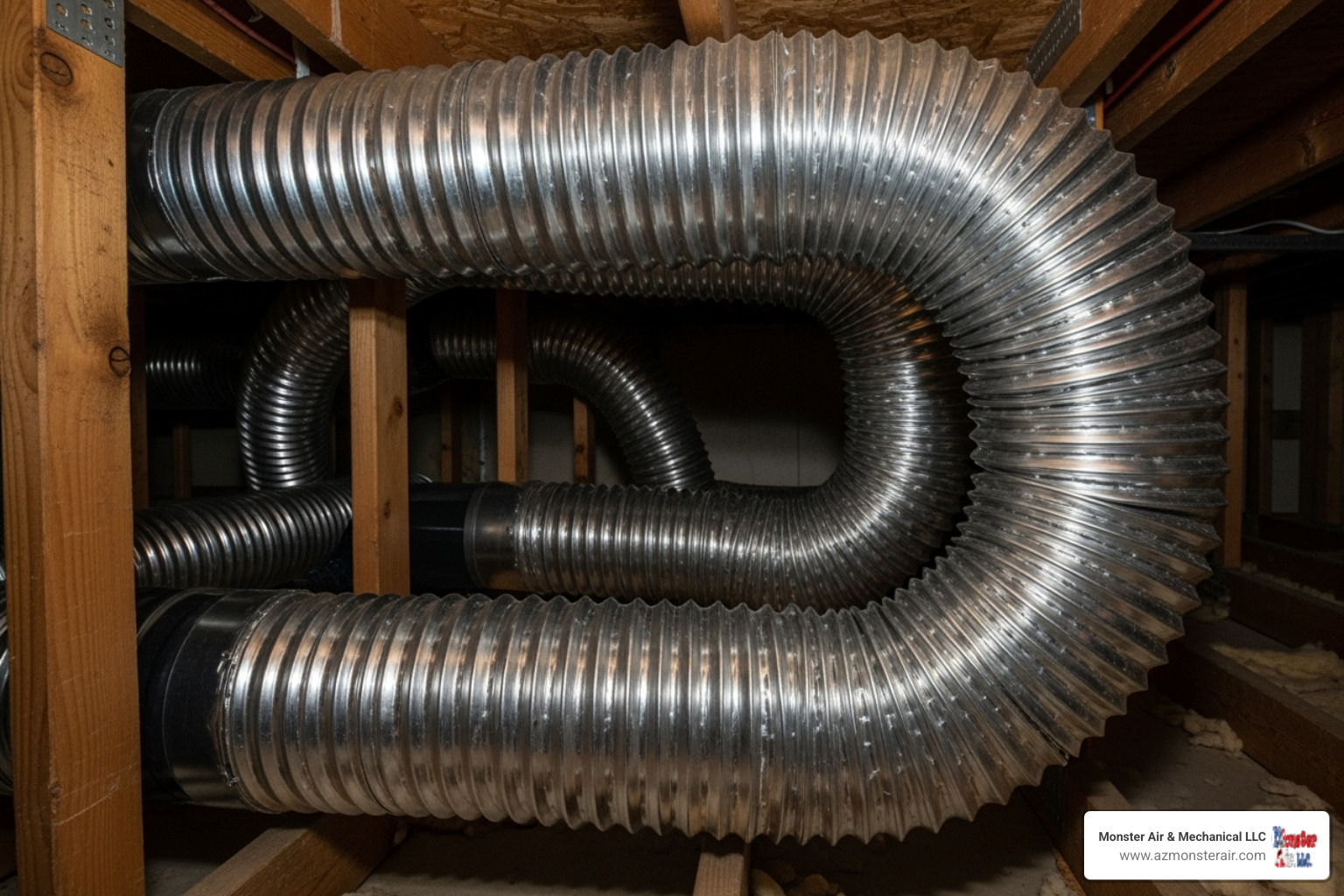

_11zon%20(1).webp)





